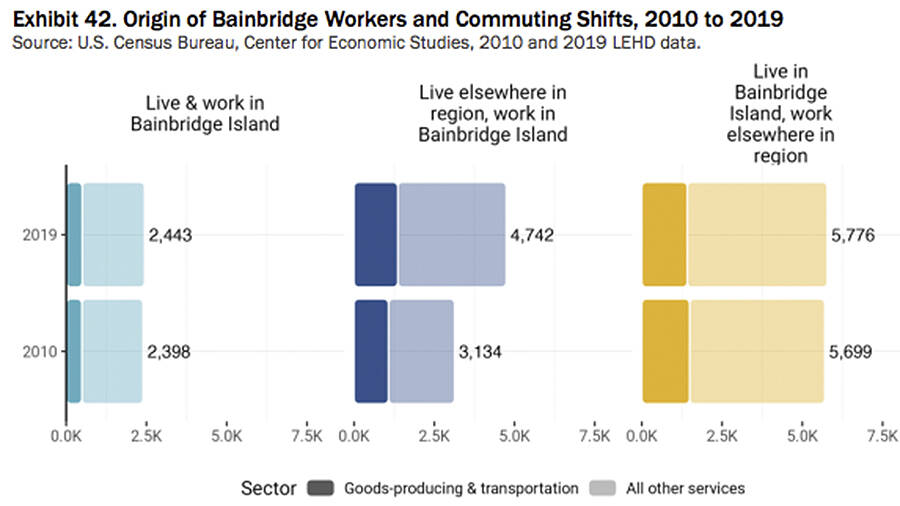Commuting has increased more than 50 percent in the past decade, as more and more people who work on Bainbridge Island can’t afford to live here.
Tiny houses and converting single-family housing to duplexes or triplexes are two of the possible quick-fix solutions, according to research team ECONorthwest, which was selected by the city to complete its Housing Action Plan. The draft housing needs assessment was discussed at the Oct. 18 City Council meeting. The council hopes to adopt a final plan by spring 2023.
Overall statistics show that Bainbridge is aging in population and losing families with children as housing prices skyrocket. That has led to declining enrollment in schools — the district hasn’t been able to collect impact fees since 2011 as a result.
The average age of an islander in 2000 was 43. In 2020, it was 50. And the number of people age 60 and older doubled in that same time period. People with children have dropped from 49 percent to 35 percent. The median sales price of a single-family home was $1.5 million in mid-2022. There are few rentals around, and their cost is $2,605 a month, up 76 percent since 2000. As a result, homeownership of those age 55 and younger dropped from 59 percent in 2000 to 33 percent in 2020. Income has gone up 13 percent during that time period, but rent has increased 43 percent and housing 83 percent in the past decade.
Jobs are increasing on BI, about 1,600 since 2000, however more than half are service jobs, which are historically low-paying positions. So many people are overly burdened with housing costs, which should be only about 30 percent of income. Some pay as high as 50 percent. Bainbridge lacks affordable housing, with only 167 rentals. Housing Resources Bainbridge has 111 families on its waiting list for those spots.
BI has come to realize there is a problem, and there has been a small increase in housing, and it is slowly becoming more diverse — multi-units rather than single-family.
Potential solutions
The research team involved the community in its efforts with two surveys, reaching out to 30 organizations, and having three community venues at the library, farmers market and Helpline House. It held three focus groups with folks like housing developers and business owners. They went to six community groups, including senior center and child care. In all, 200 employers and 800 community members participated.
To meet future housing needs as established by state law, BI will need to average 127 more housing units every year from 2023-44 — meaning 2,672 total to meet the growth goal of 4,524 new people. The housing would be focused in Winslow, Lynwood, Island Center and Rolling Bay to prevent urban sprawl.
Increased housing types need to include facilities for aging Baby Boomers, affordable housing not only for low- but also middle-income families, and more long-term rentals. But with rising construction costs, all new housing will be a challenge to be affordable, the research says.
To make a difference quickly, the research shows the city could look at more boat liveaboards, vacation rentals, reduced fees and fast-track affordable housing and cottage housing. It also says Housing Trust Fund grants have not been updated since 2010, and that could make a difference.
More strategies for the future include: partnerships, preserve existing housing programs, build affordable senior housing, address sewer and septic limitations so more housing could be built, and advocate for affordable housing nationwide.
Council comments
Councilmembers had a variety of responses to the report.
Leslie Schneider said it needs to have more information about jobs on BI. “We need housing for those people. We need to solve our workforce needs.”
Kirsten Hytopolous agreed. “Who is and who isn’t being served?” she asked, adding does BI want more housing for servers with low income or firefighters with medium income. She asked if they could get a formula to use to get the housing mix they want. “Can we have an exact policy?”
“If you’re an attorney were not trying to house you,” Brenda Fantroy-Johnson said. She added that she appreciated the report because it shows what housing is needed, where they’re lacking and that “we’re behind where we should be.”
If you’re wealthy you can find places to live, Jon Quitslund said. “We need to focus on the lower and middle” class income levels. “If the market doesn’t do it we need to find a way” not just to encourage but to make things happen. He added that rentals are BI’s greatest need, and more needs to be done to encourage that.
Michael Pollock asked what their options are as a council. What tools do they have to get a certain number of rental units or housing for certain income levels? What methods have other cities used to get their desired housing?
Mayor Joe Deets reminded the others this was a housing needs assessment report, not a how to do housing in the future report. He said that since one-third of houses on BI are vacation homes they should figure out how to encourage the use of those structures when they are vacant.
In general, Morgan Shook of ECONorthwest said BI hasn’t kept pace with demand for housing, and that’s why there are homeless, people living with parents longer, people having roommates, and people spending more of their income to live on BI. While nothing can be done about the past, Shook said a $100,000 Commerce grant for the city requires BI to look at future needs with socioeconomics playing a role in diverse housing. “Going forward you can remedy some of that” past neglect, he said.
Quitslund agreed. “We have a history to overcome. It’s been spelled out and identified. The number is imprecise, but we have a target to go after” to improve over “past practices and business as usual.”



